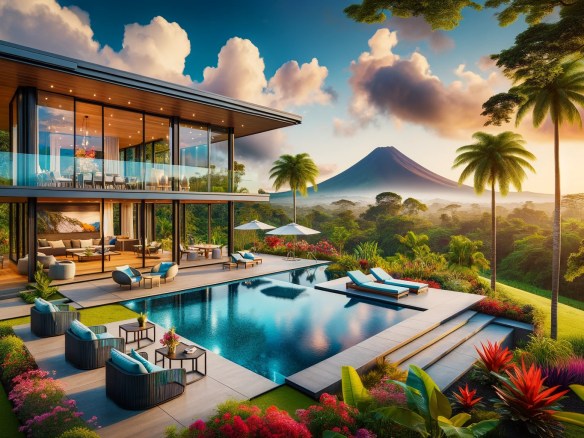Uncover the secrets of Costa Rica’s real estate hotspots. From the Pacific Coast’s surfer paradises to the Central Valley’s urban conveniences, discover where to invest, live, and thrive.
Costa Rica’s allure as a top destination for investors, retirees, and expatriates is undeniable. With its stable economy, lush landscapes, and vibrant culture, it offers unique opportunities for real estate investment. This insider’s guide navigates through the country’s real estate hotspots, revealing where to invest for lifestyle and profit.
Costa Rica: A Market Overview
Understanding the dynamics of Costa Rica’s real estate market is crucial. The nation’s economic stability, coupled with a growing interest in sustainable and eco-friendly living, has shaped current trends, making it an attractive market for investors and homebuyers alike.
The Pacific Coast: A Surfer’s Paradise
The Pacific Coast is renowned for its world-class surfing, luxury resorts, and stunning properties. Guanacaste offers a blend of luxury and lifestyle with its high-end properties. The Central Pacific is known for its accessibility to San José and more affordable options. The Southern Pacific, with its untouched beauty, appeals to those seeking solitude and connection to nature.
The Central Valley: Urban Convenience and Natural Beauty
The Central Valley combines urban convenience with natural beauty. San José, the capital, is the cultural heart of the country, offering urban amenities alongside historic charm. Heredia, with its cooler climate and green spaces, is perfect for those seeking tranquility. Alajuela, the gateway to Costa Rica’s famous volcanoes, offers scenic beauty and a slower pace of life.
The Caribbean Coast: Cultural Diversity and Lush Landscapes
The Caribbean Coast is less developed but rich in cultural diversity and natural beauty. Limón features vibrant culture and pristine beaches, while the Southern Caribbean is known for its eco-tourism and tight-knit communities.
Emerging Markets and Future Potential
Exploring emerging markets like the Nicoya Peninsula, known for its “Blue Zone” status, and the untapped potential of South-Central Costa Rica, can yield high returns for early investors.
Investment Opportunities
Costa Rica offers diverse investment opportunities, from vacation rentals that capitalize on the booming tourism sector to residential developments and commercial ventures catering to the expatriate and local markets.
Navigating the Buying Process
The buying process in Costa Rica involves several steps, including understanding legal considerations, finding the right real estate agent, and securing financing. This section provides a roadmap for prospective buyers.
Living in Costa Rica
Life in Costa Rica offers numerous benefits, from the Pura Vida lifestyle to the sense of community and access to excellent healthcare and education. However, integrating into the community and adapting to the local way of life are important considerations.
Challenges and Considerations
Prospective buyers should be aware of environmental regulations, infrastructure and accessibility issues, and potential market fluctuations. These challenges, while manageable, are important factors to consider when investing in Costa Rican real estate.
FAQs: Your Questions Answered
This section addresses common queries about buying and living in Costa Rica, offering practical advice and insights to help readers make informed decisions.
Costa Rica: A Market Overview:
What are the current trends and dynamics of the Costa Rican real estate market, and why is it considered attractive for investors and homebuyers?
The Costa Rican real estate market is characterized by its dynamic and diverse nature, driven by the country’s economic stability, commitment to environmental sustainability, and its status as a preferred destination for expatriates, retirees, and investors. Here’s a closer look at the key factors making Costa Rica’s real estate market attractive:
Economic Stability: Costa Rica boasts a stable economy with steady growth, supported by a strong democracy and diversified sectors, including a booming tourism industry. This stability is a significant attractor for real estate investment, providing a solid foundation for property value appreciation and rental income opportunities.
Sustainable and Eco-Friendly Living: The nation’s global leadership in sustainability, with ambitious goals like achieving carbon neutrality by 2050, resonates in its real estate market. There’s a growing demand for properties that incorporate green building practices, renewable energy, and eco-friendly materials, appealing to a global audience that values environmental responsibility.
Market Trends: The market is buoyed by consistent demand from expatriates and retirees, drawn by Costa Rica’s natural beauty, climate, and quality of life. This demand is not just for traditional expat hotspots but also for rural and less developed areas, fueled by the rise of remote work and digital nomadism. Developments offering community, lifestyle amenities, and nature integration are especially sought after.
Challenges and Opportunities: While navigating Costa Rica’s regulatory and environmental protection laws poses challenges, it also ensures sustainable development and preservation of the country’s natural beauty. The market’s accessibility to foreign investors, combined with its protectionist policies, balances investment opportunities with ecological and cultural preservation.
The Pacific Coast: A Surfer’s Paradise
What makes the Pacific Coast of Costa Rica a renowned surfer’s paradise, and how do the different regions like Guanacaste, the Central Pacific, and the Southern Pacific cater to diverse preferences in terms of surfing, luxury, and lifestyle?
Costa Rica’s Pacific Coast is celebrated globally for its exceptional surfing conditions, diverse lifestyle offerings, and stunning properties, making it a sought-after destination for surfers, luxury seekers, and nature enthusiasts alike. Each region along the coast—Guanacaste, the Central Pacific, and the Southern Pacific—boasts unique characteristics that cater to a wide range of preferences:
Guanacaste: Luxury and Lifestyle
World-Class Surfing: Guanacaste features some of the best surf spots in Costa Rica, including Playa Grande and Tamarindo, offering consistent waves for all skill levels.
Luxury Living: Known for its high-end properties, resorts, and amenities, Guanacaste caters to those seeking a luxurious lifestyle. The region is dotted with upscale homes, boutique hotels, and gourmet dining options, all set against a backdrop of stunning landscapes.
Active Community: The area’s vibrant expatriate and surf communities provide a lively social scene, with numerous cultural and recreational activities available year-round.
Central Pacific: Accessibility and Affordability
Surf and Convenience: The Central Pacific region, including popular spots like Jacó and Hermosa, offers excellent surfing conditions combined with easy accessibility to San José, making it ideal for weekend getaways or longer stays.
Diverse Property Options: This region provides a range of property options, from affordable condos to luxury villas, appealing to a broad spectrum of buyers and investors. Its proximity to the capital also adds convenience for healthcare, shopping, and entertainment.
Eco-Tourism and Adventure: Beyond surfing, the Central Pacific is a hub for eco-tourism, with national parks and wildlife reserves offering adventures like zip-lining, hiking, and wildlife watching.
Southern Pacific: Solitude and Natural Beauty
Untouched Paradise: The Southern Pacific, with areas like Dominical and the Osa Peninsula, is celebrated for its untouched beauty and secluded beaches. It’s a haven for those seeking solitude and a deep connection to nature.
Eco-Friendly Living: Emphasizing sustainability, properties in this region often incorporate eco-friendly designs and practices, aligning with the area’s strong ethos of conservation and environmental stewardship.
Surfing in Solitude: The surf spots in the Southern Pacific are less crowded, offering surfers pristine conditions in a more tranquil setting. The waves here can range from beginner-friendly to challenging, surrounded by some of Costa Rica’s most breathtaking natural scenery.
The Pacific Coast of Costa Rica is a surfer’s paradise not only for its exceptional waves but also for the diverse lifestyles and properties it offers. From the luxury and vibrant lifestyle of Guanacaste, the accessibility and affordability of the Central Pacific, to the untouched beauty and solitude of the Southern Pacific, there’s something to satisfy every preference, making it a truly unparalleled destination.
The Central Valley: Urban Convenience and Natural Beauty
How does the Central Valley of Costa Rica blend urban convenience with natural beauty, particularly in areas like San José, Heredia, and Alajuela?
The Central Valley of Costa Rica masterfully combines the advantages of urban living with the allure of natural beauty, making it a unique and desirable location for both residents and visitors. This region, cradled by mountains and dotted with volcanoes, offers a variety of lifestyles, from the vibrant cultural life of San José to the tranquil, green surroundings of Heredia and Alajuela.
San José: The Cultural Heart
Urban Amenities: As the capital city, San José is the bustling urban center of Costa Rica, offering a wide range of amenities including shopping centers, restaurants, cafes, and hospitals. The city is well-equipped to cater to all urban needs.
Historic Charm: San José boasts a rich cultural scene, with numerous theaters, museums, and galleries that celebrate Costa Rican art and history. The city’s architecture, ranging from colonial to modern, adds to its charm.
Green Spaces: Despite its urban nature, San José offers pockets of tranquility with its parks and green spaces, such as La Sabana Metropolitan Park, providing residents with a break from the city hustle.
Heredia: Tranquility and Cooler Climate
Cooler Climate: Located to the north of San José, Heredia benefits from a cooler climate, thanks to its higher elevation. This makes it an attractive option for those seeking comfort away from the tropical heat.
Green Spaces: Known as “The City of Flowers,” Heredia is surrounded by lush greenery and coffee plantations, offering a peaceful environment and scenic beauty. It’s perfect for outdoor activities like hiking and bird watching.
Cultural and Educational Hub: Heredia is home to one of the country’s main universities, contributing to a vibrant academic atmosphere. Cultural events, cafes, and bookshops cater to the student population and residents alike.
Alajuela: Gateway to Natural Wonders
Scenic Beauty: Alajuela provides easy access to some of Costa Rica’s most famous natural attractions, including the Poás and Arenal Volcanoes. Its landscape is characterized by rolling hills, volcanic lakes, and lush forests.
Slower Pace of Life: Compared to San José, Alajuela offers a more relaxed lifestyle, with a friendly local community and a slower pace of life that appeals to those looking for a serene environment.
Rich Biodiversity: The region’s rich biodiversity can be explored in nearby national parks and reserves, making it a haven for nature lovers and those passionate about outdoor adventures.
For more information click here!
The Caribbean Coast: Cultural Diversity and Lush Landscapes
The Caribbean Coast of Costa Rica stands out as a region less touched by extensive development, yet it boasts an incredible wealth of cultural diversity and natural beauty. This area, stretching from the bustling port city of Limón down to the tranquil Southern Caribbean shores, offers a unique blend of vibrant culture, pristine beaches, and lush landscapes, making it a distinct contrast to the country’s Pacific side.
Limón: A Melting Pot of Cultures
Limón, the capital city of the Caribbean province, is a lively hub that encapsulates the rich cultural tapestry of the region. It is renowned for its multicultural heritage, with strong influences from Afro-Caribbean, Indigenous, and Costa Rican cultures. This diversity is celebrated through music, dance, cuisine, and festivals, most notably the vibrant Carnaval, which fills the streets with colorful parades and Calypso music.
The city and its surroundings boast some of Costa Rica’s most untouched beaches, such as Playa Bonita and Cahuita, where the jungle meets the sea. The area is also the gateway to several protected areas, including the Tortuguero National Park, often referred to as the “Amazon of Costa Rica” due to its rich biodiversity and network of waterways.
Southern Caribbean: Eco-Tourism and Community
The Southern Caribbean, encompassing areas like Puerto Viejo de Talamanca, Cahuita, and Manzanillo, is celebrated for its laid-back lifestyle, eco-tourism initiatives, and tight-knit communities. The region’s commitment to sustainability and conservation is evident in its eco-lodges, organic farms, and wildlife sanctuaries.
This part of the Caribbean Coast is a paradise for nature lovers and adventure seekers. The lush rainforests are home to a wide array of wildlife, while the coral reefs off the coast offer excellent snorkeling and diving opportunities. The area’s beaches, such as Punta Uva and Playa Chiquita, are renowned for their beauty and tranquility, providing perfect spots for relaxation and surf enthusiasts alike.
Cultural and Natural Harmony
The Caribbean Coast’s distinct vibe is attributed to its fusion of cultures and dedication to preserving its natural environment. The communities here, though diverse in their backgrounds, share a common respect for nature and a commitment to eco-friendly living. This ethos, combined with the area’s natural wonders, from dense rainforests to coral reefs, creates a unique destination for those seeking an authentic and sustainable travel experience.
In essence, Costa Rica’s Caribbean Coast offers a rich, immersive experience that combines cultural diversity with stunning natural landscapes. From the vibrant city of Limón to the serene and eco-conscious Southern Caribbean, this region invites visitors and residents to explore its unique heritage, engage with its communities, and revel in its natural splendor, all while fostering a deep connection with the environment.
Emerging Markets and Future Potential
Question: How do emerging markets like the Nicoya Peninsula and South-Central Costa Rica present opportunities for high returns to early investors, considering their unique attributes and future potential?
Emerging markets within Costa Rica, particularly the Nicoya Peninsula and South-Central regions, offer intriguing investment opportunities due to their unique characteristics and untapped potential. Here’s why these areas are attracting attention from savvy investors:
Nicoya Peninsula: A “Blue Zone” with Growing Appeal
Health and Longevity: The Nicoya Peninsula is one of the world’s recognized “Blue Zones,” areas where people live longer and healthier lives. This distinction attracts individuals and investors interested in wellness, eco-tourism, and sustainable living.
Natural Beauty and Lifestyle: With its pristine beaches, lush forests, and a strong community focus on sustainability, the Nicoya Peninsula offers a desirable lifestyle that appeals to retirees, wellness enthusiasts, and tourists. The increasing demand for real estate in areas promoting health and wellness can drive property values and rental yields.
Development Potential: While parts of the Nicoya Peninsula are well-developed, other areas remain relatively untouched, offering opportunities for early investors to enter the market before prices rise in response to growing interest and development.
South-Central Costa Rica: Untapped Potential
Biodiversity and Eco-Tourism: South-Central Costa Rica is known for its rich biodiversity, including untouched rainforests, national parks, and conservation areas. The region’s potential for eco-tourism ventures is significant, appealing to a growing segment of travelers seeking authentic nature experiences.
Accessibility and Infrastructure Improvements: As infrastructure continues to improve, with better roads and increased accessibility, previously hard-to-reach areas are becoming more attractive to investors and developers. Early investment in these emerging markets can yield high returns as the region becomes more accessible and popular.
Community and Sustainability: Like the Nicoya Peninsula, South-Central Costa Rica has a strong emphasis on community and environmental sustainability. Investments that align with these values, such as eco-lodges, organic farms, and sustainable housing developments, are particularly well-received and supported by both local and expatriate communities.
Investing in emerging markets like the Nicoya Peninsula and South-Central Costa Rica requires a forward-thinking approach, considering both the intrinsic appeal of these regions and their future potential. The emphasis on health, wellness, and sustainability, combined with natural beauty and improving accessibility, positions these areas for growth in the real estate and tourism sectors. Early investors who recognize the unique opportunities presented by these regions can capitalize on the increasing demand for properties and experiences that align with global trends towards healthy and sustainable living.
Investment Opportunities
What are the diverse investment opportunities in Costa Rica that cater to the booming tourism sector, expatriate, and local markets, including vacation rentals, residential developments, and commercial ventures?
Costa Rica’s robust economy, political stability, and reputation as a premier ecotourism destination create a fertile ground for diverse investment opportunities. The country’s appeal to tourists, expatriates, and locals alike has spurred growth in various sectors, offering lucrative prospects for investors. Here’s a breakdown of some of the key investment opportunities:
Vacation Rentals:
Tourism Sector Boom: With Costa Rica’s tourism industry witnessing year-on-year growth, investing in vacation rentals presents a significant opportunity. Properties in high-demand areas, such as near national parks, beaches, and other tourist attractions, can yield high returns, especially during the peak tourist seasons.
Diverse Market: The market for vacation rentals is diverse, catering to budget backpackers, luxury travelers, and eco-tourists. Properties that offer unique experiences or cater to specific niches, such as eco-friendly accommodations or wellness retreats, are particularly well-positioned to capitalize on tourism trends.
Residential Developments:
Expatriate Demand: The steady influx of retirees and expatriates, drawn by Costa Rica’s high quality of life and natural beauty, has fueled demand for residential properties. Gated communities, condos, and single-family homes in areas with established expatriate populations offer solid investment prospects.
Local Market Growth: As the local middle class grows, so does the demand for modern, affordable housing. Investing in residential developments that cater to local preferences and needs, including security, amenities, and proximity to urban centers, can tap into this expanding market.
Commercial Ventures:
Retail and Office Space: The increasing population and economic activity, particularly in urban areas and expatriate hubs, drive demand for retail and office spaces. Investments in commercial properties, shopping centers, and mixed-use developments can cater to the burgeoning need for services and amenities.
Eco-Tourism and Adventure Tourism: Developing or investing in businesses that offer eco-tourism and adventure activities, such as guided tours, conservation projects, and adventure sports, leverages Costa Rica’s natural assets and reputation as an eco-tourism leader.
Agricultural and Sustainable Ventures:
Organic Farming: With a global shift towards organic and sustainably produced goods, investing in organic farming and related agribusiness ventures can tap into both local and international markets.
Renewable Energy Projects: Costa Rica’s commitment to renewable energy and sustainability presents opportunities for investment in solar, wind, and hydroelectric projects, contributing to the country’s energy independence and attracting eco-conscious investors.
Investment opportunities in Costa Rica are as diverse as its landscapes, driven by the country’s commitment to sustainability, a growing economy, and an expanding market of tourists, expatriates, and locals. By focusing on sectors such as vacation rentals, residential developments, commercial ventures, and sustainable projects, investors can tap into the country’s potential for high returns while contributing to its sustainable development goals.
Navigating the Buying Process
Navigating the buying process in Costa Rica can be a straightforward experience with the right preparation and guidance. The country’s welcoming stance towards foreign investors, combined with its stable economy and political environment, makes it an attractive destination for property buyers. However, understanding the legal landscape, finding a reputable real estate agent, and securing financing are crucial steps in the process. Here’s a comprehensive roadmap for prospective buyers:
1. Understanding Legal Considerations
Property Rights: Costa Rica allows foreigners the same property rights as locals, but it’s important to be aware of specific legal considerations, especially regarding properties in coastal zones (Maritime Zone) and protected areas.
Due Diligence: Conduct thorough due diligence on any property of interest. This includes verifying the property title, ensuring there are no liens or encumbrances, and understanding any zoning restrictions that may apply.
2. Finding the Right Real Estate Agent
Expertise and Credentials: Choose an agent with a strong track record and expertise in the area where you’re looking to buy. Verify their credentials and ask for references to ensure they are reputable and have experience working with foreign buyers.
Local Knowledge: A knowledgeable agent can provide invaluable insights into local market trends, legal requirements, and can guide you through the buying process smoothly.
3. Securing Financing
Local vs. International Financing: While some Costa Rican banks offer mortgages to foreigners, the terms may differ from those in your home country. Alternatively, securing financing from your country of residence might be a more viable option.
Understanding Costs: Be prepared for additional costs associated with buying property, including legal fees, transfer taxes, and notary fees. These can typically amount to 3.5% to 4.5% of the purchase price.
4. Making an Offer and Negotiating
Sales Agreement: Once you’ve found a property and decided to proceed, a sales agreement (or purchase contract) will be drafted. This document outlines the terms of sale, including price, payment schedule, and any contingencies, such as obtaining financing or satisfactory property inspections.
Negotiation: Negotiation is a standard part of the buying process. Your real estate agent can provide guidance on making a competitive offer based on their knowledge of the local market.
5. Closing the Deal
Closing Process: The closing process involves the final exchange of documents and the payment of the purchase price. In Costa Rica, this is typically facilitated by a notary public (who has broader legal powers than in some countries), ensuring that all legal aspects are properly addressed.
Registration: After closing, the property must be registered in your name in the National Registry (Registro Nacional), completing the transfer of ownership.
6. Post-Purchase Considerations
Utilities and Services: Arrange for the transfer of utilities and services into your name. Your real estate agent or attorney can often assist with this process.
Property Management: If you’re purchasing the property as a vacation home or investment, consider hiring a property management company to look after the property in your absence.
Buying property in Costa Rica is an exciting opportunity that requires careful planning and understanding of the local real estate market and legal framework. By following these steps and working with experienced professionals, prospective buyers can navigate the buying process confidently, securing their ideal property in this beautiful country.
Living in Costa Rica
What are the benefits and considerations for living in Costa Rica, and how can expatriates successfully integrate into the local community and adapt to the “Pura Vida” lifestyle?
Living in Costa Rica offers a blend of enriching experiences, underscored by the nation’s “Pura Vida” ethos, a philosophy that emphasizes living life to the fullest and maintaining a positive, relaxed attitude. This lifestyle, along with Costa Rica’s welcoming communities, stunning natural environment, and excellent healthcare and education systems, presents a compelling case for those considering making Costa Rica their home. Here are the key benefits and considerations for expatriates, along with tips for successful integration:
Benefits of Living in Costa Rica
Pura Vida” Lifestyle: Embracing this lifestyle means adopting a laid-back approach, fostering happiness, contentment, and a closer connection to nature.
Community: Costa Rica’s friendly populace makes it relatively easy for expatriates to integrate and form connections within diverse local and international communities.
Natural Beauty: The country’s varied ecosystems provide a backdrop for a range of outdoor activities, supporting a healthy and active lifestyle.
Healthcare: With both public and private healthcare options available, residents have access to affordable and high-quality medical services.
Education: The education system in Costa Rica is robust, offering numerous high-quality public and private schooling options, including bilingual and international programs.
Considerations for Integration and Adaptation
Language Learning: Gaining proficiency in Spanish is crucial for deeper community integration and enhancing daily life experiences in Costa Rica.
Cultural Adaptation: Understanding and adapting to local customs, such as the relaxed concept of time and active participation in festivals and traditions, is important for a smooth transition.
Sustainability: Adopting eco-friendly practices aligns with Costa Rica’s strong emphasis on environmental conservation, an important aspect of life in the country.
Tips for Successful Integration
Active Community Engagement: Participation in local events, volunteering, and attending social gatherings can facilitate meaningful connections and cultural immersion.
Openness and Flexibility: Approach differences with an open mind and be patient as you adjust to the new environment and lifestyle. Flexibility is key to overcoming challenges and enjoying the richness of Costa Rican culture.
Leveraging Support Networks: Utilize expatriate forums, social media groups, and community resources for advice and support from those who have navigated similar transitions.
Life in Costa Rica presents a rewarding opportunity for expatriates to immerse themselves in a culture and lifestyle that values happiness, community, and harmony with nature. While the transition involves navigating language and cultural differences, the benefits of living in this beautiful country can be maximized through active engagement, openness to new experiences, and embracing the “Pura Vida” way of life. With these approaches, expatriates can successfully integrate into their new community and fully enjoy the myriad benefits of living in Costa Rica.
Challenges and Considerations
What are the main challenges and considerations prospective buyers should be aware of when investing in Costa Rican real estate, including environmental regulations, infrastructure, accessibility, and market fluctuations?
Investing in Costa Rican real estate offers numerous opportunities, but it also comes with its set of challenges and considerations that prospective buyers need to navigate carefully. Understanding these factors is crucial for making informed decisions and ensuring a successful investment. Here are some of the primary challenges and considerations to keep in mind:
Environmental Regulations:
Costa Rica is known for its commitment to environmental preservation, which is reflected in its strict environmental regulations. Prospective buyers should be aware that certain areas may have restrictions on development to protect biodiversity. It’s essential to conduct thorough due diligence to ensure compliance with environmental laws and to ascertain any restrictions on the property of interest.
Infrastructure and Accessibility:
While Costa Rica’s infrastructure continues to improve, there are still areas, especially in more remote or rural locations, where access to basic services such as electricity, water, and internet may be limited or less reliable. Understanding the state of infrastructure and accessibility is crucial, particularly if considering investment in undeveloped land or properties outside of major urban centers.
Market Fluctuations:
Like any real estate market, Costa Rica’s market is subject to fluctuations influenced by both local and global economic conditions. While the country’s real estate market has shown resilience and growth, especially in areas popular with tourists and expatriates, investors should be prepared for potential market shifts. Keeping abreast of economic trends and seeking advice from local real estate experts can help mitigate risks associated with market volatility.
Navigating Legal Requirements:
The process of buying property in Costa Rica involves navigating legal requirements, including property registration, transfer taxes, and potentially complex laws regarding coastal properties (Maritime Zone law). Engaging a reputable local attorney who specializes in real estate law is imperative to navigate these legal aspects successfully.
Language Barrier:
For non-Spanish speakers, the language barrier can present a challenge in understanding legal documents, negotiating deals, and managing properties. Employing bilingual professionals, such as real estate agents and lawyers, can help overcome this challenge.
While the challenges and considerations of investing in Costa Rican real estate are manageable, they underscore the importance of thorough preparation, due diligence, and seeking expert advice. By being well-informed about environmental regulations, infrastructure, market conditions, and legal requirements, prospective buyers can navigate the complexities of the Costa Rican real estate market more effectively, making for a more secure and potentially lucrative investment.
FAQs: Buying and Living in Costa Rica
1. What are the main steps in buying property in Costa Rica?
The main steps include identifying a property, conducting due diligence (checking title, liens, and permits), negotiating the purchase, drafting and signing a sale agreement, and finally, registering the property in your name at the National Registry.
2. Do I need a local bank account to buy property in Costa Rica?
While not strictly necessary to purchase property, having a local bank account can simplify paying for utilities, property taxes, and maintenance expenses. Some banks may require residency status for opening an account.
3. What are the legal considerations for buying property near the coast?
Properties within the first 200 meters of the high-tide line are considered Maritime Zone and are subject to special regulations. Foreigners can lease land in this zone through a concession from the local municipality, but direct ownership is restricted.
4. How does the healthcare system work for expatriates in Costa Rica?
Expatriates who become legal residents are required to join the Costa Rican Social Security Fund (Caja), which provides access to the public healthcare system. Many expatriates also choose to have private healthcare insurance for access to private hospitals and clinics.
5. What is the cost of living like in Costa Rica?
The cost of living can vary widely depending on your lifestyle, location, and housing choices. While certain aspects such as healthcare and fresh produce are cheaper than in the U.S. and Europe, imported goods and services can be more expensive.
6. Is learning Spanish necessary for living in Costa Rica?
While many Costa Ricans speak English, especially in tourist areas and larger cities, learning Spanish is highly beneficial for integrating into the community, managing daily affairs, and enriching your overall experience in Costa Rica.
7. What should I consider regarding the climate in Costa Rica?
Costa Rica has a diverse climate, ranging from tropical on the coasts to temperate in the highlands. Consider your climate preference when choosing a location, and prepare for the rainy season, which can significantly affect certain areas.
8. Are there any restrictions on foreigners working in Costa Rica?
Foreigners can own a business in Costa Rica, but working as an employee requires specific residency status that permits work or obtaining a work permit, which can be a complex process.
9. How can I ensure a smooth transition to life in Costa Rica?
Research extensively, visit multiple times if possible, engage with local and expatriate communities, and consider renting before buying to get a feel for different areas. Employing reputable legal and real estate professionals can also help navigate the buying process and legal requirements for living in Costa Rica.





Join The Discussion